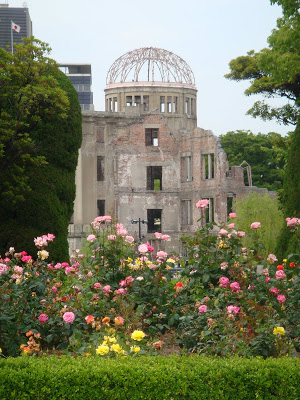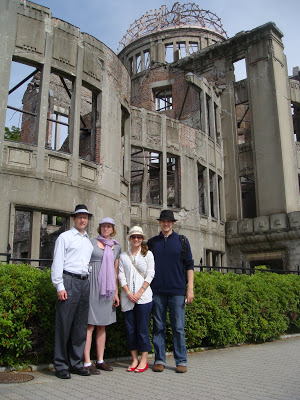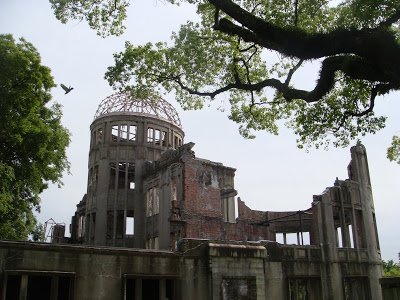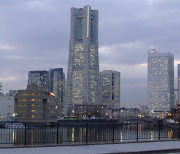 The A-Bomb Dome stands across the river from the Hiroshima Peace Park. A monument in front of the museum frames the dome with the inscription, “Let all the souls here rest in peace for we shall not repeat the evil.” It embodies the hope that Hiroshima, now regrown after the devastation of the nuclear bomb dropped on August 6, 1945, will symbolize peace forever. Within the peace park is a stone chamber containing a Register of Deceased A-bomb Victims. “It expresses the spirit of Hiroshima—enduring grief, transcending hatred, pursuing harmony and prosperity for all, and yearning for genuine, lasting world peace.”
The A-Bomb Dome stands across the river from the Hiroshima Peace Park. A monument in front of the museum frames the dome with the inscription, “Let all the souls here rest in peace for we shall not repeat the evil.” It embodies the hope that Hiroshima, now regrown after the devastation of the nuclear bomb dropped on August 6, 1945, will symbolize peace forever. Within the peace park is a stone chamber containing a Register of Deceased A-bomb Victims. “It expresses the spirit of Hiroshima—enduring grief, transcending hatred, pursuing harmony and prosperity for all, and yearning for genuine, lasting world peace.” 
I never really understood why Hiroshima was chosen as the A-bomb target, but the museum explains this city has for hundreds of years been the final point of embarkation for the Japanese military as it heads off to war in continental Asia. Part of the army was headquartered here, and many factories were producing munitions for the war effort. City officials knew these features meant a bombing at some point in the war was extremely likely and mused about how long Hiroshima could avoid damage. A rumor ran around the citizens of the city explaining the lack of bombing as proof the Americans planned to turn Hiroshima into a seaside resort after they won the war and therefore wanted to keep it intact. 

Without question, the civilian loss of life after the A-bomb is shocking, horrifying, devastating and tragic. Especially because the bomb itself was unprecedented. The bomb and later radiation sickness caused nearly 200,000 deaths. But after seeing the War Museum in Tokyo and the bomb museums in Nagasaki and Hiroshima, the emphasis on human suffering should be more proportionally distributed—lots of people died from the A-bomb, but that shouldn’t overshadow the rest of the nation’s suffering. All three museums make the point that because the Japanese Army had never been defeated—EVER—they were in the mindset to fight on to death or victory, even as their nation slowly starved to death and lived each day in fear of invasion. Without the catastrophic shock of the A-bomb the war could have lingered indefinitely. Of course the A-bomb loss of life is unimaginably horrifying…but 160,000 people, many of them women and children, died in the fight over Okinawa alone. Villages were told the Americans were unspeakably barbaric and the better alternative to surrender was honorable suicide. Entire communities leaped from cliffs to their deaths. Their loss of life was just as horrifying, but less unprecedented—maybe that’s why the A-bomb victims get so much more press.  I left the Peace Park Museum completely depressed. War, death, destruction—yes, terrible. But as long as evil exists in the world our nation and allies will be confronted with threats to our well-being and safety. I see, on a daily basis, the efforts of maintaining peace. It is expensive to governments and costly to families; it is dangerous and uncertain. But I hope that this strong presence and active preparation for war ultimately will prevent the atrocities depicted in these museums from happening again. Today is Memorial Day.
I left the Peace Park Museum completely depressed. War, death, destruction—yes, terrible. But as long as evil exists in the world our nation and allies will be confronted with threats to our well-being and safety. I see, on a daily basis, the efforts of maintaining peace. It is expensive to governments and costly to families; it is dangerous and uncertain. But I hope that this strong presence and active preparation for war ultimately will prevent the atrocities depicted in these museums from happening again. Today is Memorial Day.
 I left the Peace Park Museum completely depressed. War, death, destruction—yes, terrible. But as long as evil exists in the world our nation and allies will be confronted with threats to our well-being and safety. I see, on a daily basis, the efforts of maintaining peace. It is expensive to governments and costly to families; it is dangerous and uncertain. But I hope that this strong presence and active preparation for war ultimately will prevent the atrocities depicted in these museums from happening again. Today is Memorial Day.
I left the Peace Park Museum completely depressed. War, death, destruction—yes, terrible. But as long as evil exists in the world our nation and allies will be confronted with threats to our well-being and safety. I see, on a daily basis, the efforts of maintaining peace. It is expensive to governments and costly to families; it is dangerous and uncertain. But I hope that this strong presence and active preparation for war ultimately will prevent the atrocities depicted in these museums from happening again. Today is Memorial Day. .
Recommended Reading:
The Day Man Lost by the Pacific War Research Society
More than a dozen Japanese researchers compiled this evenhanded and enlightening book. It tells the story the US race to develop the A-bomb knowing that the Germans had done more atomic bomb research than the rest of the world when the Second World War began. It also tells the story of the bomb’s survivors and victims—civilian and military—in Hiroshima. The researchers give a Japanese perspective on the reality of Japan’s leadership at the time: an Army that had never lost and could never give up without losing face, and an Emperor who wanted his people’s suffering and starvation to end.

 Texas A&M 12 Under 12!
Texas A&M 12 Under 12! The Lone Star State Diaries—Richmond, Texas
The Lone Star State Diaries—Richmond, Texas How To Address Mail in Japan
How To Address Mail in Japan Yokohama Winter Sports: Couples’ Figure Skating
Yokohama Winter Sports: Couples’ Figure Skating
Very insightful Mari. My father would likely have died in the initial ground invasion of Japan if not for Harry Truman and his bombs. Now days we are inundated by uninformed pinheads who believe the US did a terrible thing in dropping the A-bombs and have not the slightest idea that Japan would undoubtedly have suffered much heavier losses if the warfare had remained conventional.